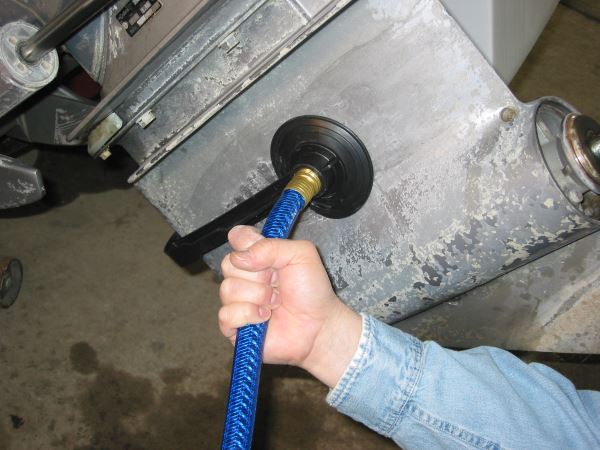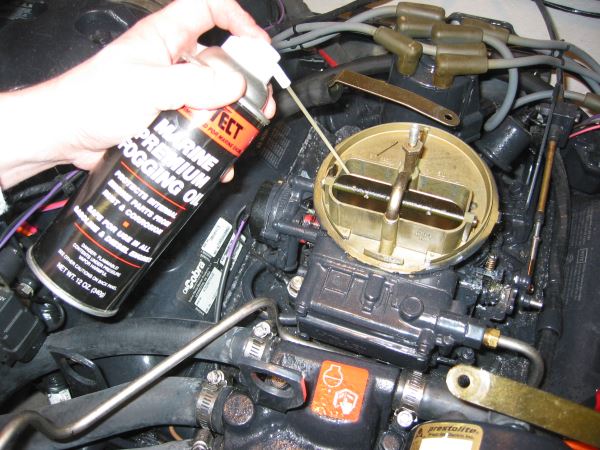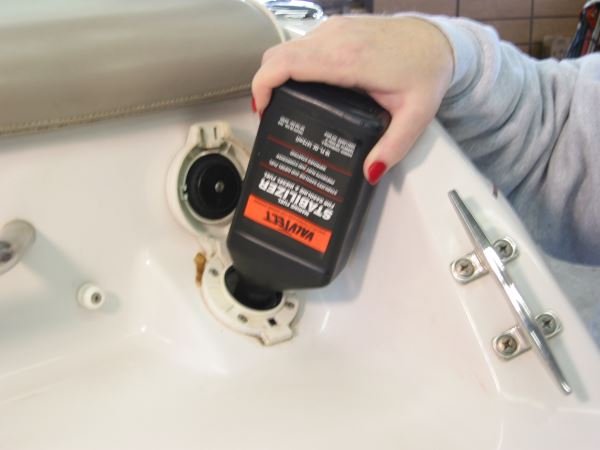
For some of you, winter doesn’t mean you quit boating, it just means you dress a bit warmer. For others of us, we change from boating to snowmobiling. When I was a kid, my family’s business was not just a boat and camper dealer; we became the first Ski-Doo Snowmobile dealer. We had Ski-Doo and Evinrude snowmobiles. When I think back it always seems like there was more snow over the winter and it was a lot more fun than now. Although as a friend once said, “Time has a way of making history better than it really was.” This might be the case, because in reality I do miss the water and I don’t look forward to the snow and the ice. But nevertheless, cold weather is on the way. And as a boater in the upper Midwest, our slip is only good until the 15th of October. After that the boat has to be stored on shore. Doesn’t mean I can’t use it, but typically, I use this date as the end of the season and a time when I need to get the boat ready for the winter storage season.
Taking a boat out of service for the winter requires the owner to take preventative steps to prevent corrosion and damage to the boats and its systems. In the Northern states it is often called winterization, but in reality any time the boat is in a “lay-up” situation for a number of months, the owners should take steps to protect their investment. Most of the following items can be done on the trailer, in the slip on the lift, or in a shop. If you have a larger boat that stays in the water you will also want to makes sure that your boat is protected from the lake freezing by using bubblers to prevent ice buildup against the hull.

Each boat is different and the options and systems on yours might need additional items serviced. If you are planning on doing all the work, make sure you have a copy of the boat, engine, and systems service manuals.
By following a simple checklist and with a little elbow grease, you can protect your boat during lay-up. If you are uncomfortable doing any of these items, call a professional.
- Add a fuel stabilizer (gas or diesel) to preserve both the fuel and the fuel tank for the upcoming winter and spring months. If you are running ethanol it’s even more important to run fuel additives to remove the water that collects.
- Run the engine, checking the timing and basic operations. This also distributes the fuel stabilizer throughout the fuels system.
- Remove the boat from the water and inspect the exterior for damage. Make any repairs or notes to remind you in the spring and give the boat a coat of wax.
- You will need to protect the internal passageways of the engine from freezing. Depending on the type of engine and cooling system you may need to add antifreeze to the cooling system (partial or fully closed cooling systems). You might need to drain the water from the engine block and manifolds and refill with marine-grade non-toxic antifreeze. This can be done using an inexpensive flushing adapter, garden hoses, and antifreeze.
- During the time you are flushing and refilling the cooling system, spray sticky “fogging” oil in the carburetor or intake while the engine is running. Fogging oil will stick to the engine’s internal passageways, giving the inside of the engine a protective coating against corrosion.
- After you have filled the cooling passages with antifreeze and fogged the engine, shut the engine off and inspect the lower unit. Remove the bottom plug in the lower unit and remove any water that might be mixed with the oil (hopefully there will not be any water or you might need more repairs in the spring).
- Inspect the throttle, steering, and shift cables for binding and wear.
- Apply anti-corrosion grease to all fittings, linkages, and steering cables.
- Check all the belts, hoses, and the general condition of the engine, drive unit, and lower unit. I wait to change the oils and belts until spring, but make a list now.
- Remove any items from the cabin that might freeze.
- Remove any food that would attract rodents and bugs.
- Place some type of anti-moisture containers (like Damp Rid) throughout the cabin to help reduce any moisture buildup that could cause mold and mildew over the winter. Oftentimes it’s a good idea to place the cushions and mattresses on an edge or lifted up with small blocks so there can be airflow over more surface areas.
- If you have a water system, galley, and head, you will need to drain the water and refill the system with non-toxic marine-grade antifreeze also.
- Last, cover the boat to keep out the elements, animals, and bugs using tarps or shrink wrap; either works. If it’s too airtight the boat will get large amounts of condensation leading to mold and mildew. Make sure that however you cover the boat it is tight but still has airflow.
Depending on your dock and lift, the winter might not mean anything but removing the slip cover and greasing and checking the cables. If it is a floating dock it might require removing the dock from the water and storing. Whichever you do, this is the time for a little preventative maintenance. Preventative maintenance reduces the overall cost of ownership. Repairing before breaking extends the life of the item and reduces the cost of repairs.

Inspect the dock and lift for damage and corrosion. Lubricate any pulleys and cables with good quality water-resistant (marine-grade) grease. This is also a good time to spray any cables with a rust and moisture inhibitor like WD40.
Remove any damaged boards or surface sections and replace. If you don’t remove and replace at this time, make a list or what’s wrong and what parts you need to order. Order them early so you don’t forget. One good reason to do the repairs now is so that you are not pressured to get the repairs done when the dock’s back in the water come spring time. No one likes to miss a spring day of boating because you are waiting for parts for your boat, dock, or lift.
Paint or treat any surface material to seal the moisture out.
Other things I like to plan are the upgrades and modifications I want to do over the winter. By the end of the season I usually have a list of things to do. For example, last year it was a adding a Pontoon Wholesalers third pontoon kit and the year before it was changing to SeaStar hydraulic steering. This year I’m thinking of removing the carpet on the front and rear and maybe adding more lights. Whatever the project, planning early helps me get the parts ordered and everything ready to go. It seems like I am always busy when it’s time to get the ‘toon ready for the water.

